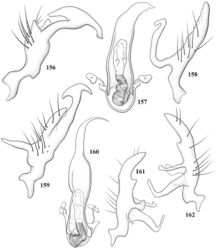Ceratocapsidea baranowskii
| Notice: | This page is derived from the original publication listed below, whose author(s) should always be credited. Further contributors may edit and improve the content of this page and, consequently, need to be credited as well (see page history). Any assessment of factual correctness requires a careful review of the original article as well as of subsequent contributions.
If you are uncertain whether your planned contribution is correct or not, we suggest that you use the associated discussion page instead of editing the page directly. This page should be cited as follows (rationale):
Citation formats to copy and paste
BibTeX: @article{Henry2015ZooKeys, RIS/ Endnote: TY - JOUR Wikipedia/ Citizendium: <ref name="Henry2015ZooKeys">{{Citation See also the citation download page at the journal. |
Ordo: Hemiptera
Familia: Miridae
Genus: Ceratocapsidea
Name
Ceratocapsidea baranowskii Henry sp. n. – Wikispecies link – ZooBank link – Pensoft Profile
Diagnosis
This species (Fig. 29) is distinguished by the dark brown head; shiny, finely punctate, dark brown pronotum; slightly paler brown hemelytra, with numerous white scale-like setae, intermixed with relatively long, semierect simple setae; and the male genitalia, especially the left paramere (Fig. 159) with a small, beak-like, apical process and two middle processes with the basal one erect and directed outward, and the complex right paramere (Figs 161, 162) with multiple arms and processes.
Description
Male (n = 6; holotype measurements in parentheses): Length 3.30–3.65 mm (3.65 mm), width 1.09–1.22 mm (1.15 mm). Head: Width 0.75–0.78 mm (0.77 mm), interocular width 0.21–0.22 mm (0.22 mm). Labium: Length 1.17–1.23 mm (1.23 mm). Antenna: Segment I, length 0.17–0.18 mm (0.18 mm); II, 0.77–0.85 mm (0.85 mm); III, 0.38–0.40 mm (0.40 mm); IV, 0.38–0.42 mm (0.42 mm). Pronotum: Length 0.64–0.67 mm (0.67 mm), basal width 1.15–1.20 mm (1.20 mm).
Coloration: Overall coloration brown to dark brown. Head: Dark brown, eyes grayish brown, weakly tinged with red on some specimens. Pronotum: Dark brown; mesoscutum brown, scutellum brown, becoming paler yellowish brown on distal half. Hemelytron: Brown to yellowish brown, cuneus dark brown; membrane and vein translucent brown, paler along basal margins. Ventral surface: Thoracic segment dark brown; abdomen brown to yellowish brown. Ostiolar evaporative area: Uniformly yellowish brown. Legs: Coxae yellowish brown; femora pale yellowish brown on basal fourth, fore and middle femora brown distally, hind femur dark brown distally; tibiae dark brown; tarsi and claws brown to yellowish brown.
Structure, texture, and vestiture: Head: Finely faceted, with scattered, short, recumbent simple setae. Antenna: Relatively thickened, segment IV and apical diameters of segments II and III subequal to diameter of segment I. Labium: Extending to bases of hind coxae. Pronotum: Shiny, evenly and finely punctate, except for finely granulate calli; with scattered, short, recumbent simple setae, intermixed with a few longer, erect, simple setae. Mesoscutum: Finely punctate. Scutellum: finely punctate and weakly transversely rugose, with scattered, small, white, scale-like setae, intermixed with a few long, erect, bristle-like setae. Hemelytron: Shiny, evenly punctate, with numerous small, white, scale-like setae especially on clavus and basal half of corium, intermixed with long, erect, bristle-like setae.
Male genitalia: Left paramere (Fig. 159) elongate, with a beak-like distal process, and two middle processes, the basal one erect, apically acute and directed outward, and middle process prostrate, lying flat against the main body. Phallotheca (Fig. 160) elongate, tapering distally to a fine point; tapered point varying from relatively short to long and nearly thread-like. Right paramere (Figs 161, 162) with one large and one small lateral arm arising from stout main stem in caudal aspect, and one short, apically rounded and one short slender process on anterior side.
Female: Unknown.
Etymology
This species is named in honor of my good friend and colleague, Dr. Richard M. Baranowski (University of Florida, Homestead), who has done much to advance our knowledge of the Heteroptera with his many collections, especially from South Florida and the West Indies, and his numerous important publications, including How to Know the True Bugs (Slater and Baranowski 1978[1]), the Coreidae of Florida (Baranowski and Slater 1986[2]), the Lygaeidae of Florida (Slater and Baranowski 1990[3]), and the Lygaeidae of the West Indies (Baranowski and Slater 2005[4]).
Host
Unknown.
Distribution
Known only from Jamaica.
Type material
Holotype ♂: Jamaica: St. Andrew Parish: Holywell Forest Camp, 4000 ft, Jan 1972–Jul 1972, M. Winegar, Holotype, (00286065) (USNM). Paratypes: Portland Parish: Green Hills Institute Jamaica Cabin, 23 Nov 1968, R. E. Woodruff, Paratype, 1♂ (00286061) (USNM); 17 Aug 1969, R. E. Woodruff, 2♂♂ (00286059, 00286060) (FSCA); 13 Dec 1969, E.G. Farnworth, 1♂ (00286062) (USNM). St. Andrew Parish: Holywell Forest Camp, Jan 1972 - Jul 1972, M. Winegar, Holotype, 1♂ (USNM); 19 Jul 1972, M. Winegar, 1♂ (00286064) (USNM); 04 Aug 1972, M. Winegar, 1♂ (00286063) (USNM). Holywell Forest Camp, 1219 m, Sep 1971 - Oct 1971, M. Winegar, 1♂ (00286058) (USNM); 01 Sep 1971, M. Winegar, 1♂ (00286057) (USNM); 16 Dec 1971, M. Winegar, 1♂ (00286056) (USNM).
Original Description
- Henry, T; 2015: Revision of the Ceratocapsine Renodaeus group: Marinonicoris, Pilophoropsis, Renodaeus, and Zanchisme, with descriptions of four new genera (Heteroptera, Miridae, Orthotylinae) ZooKeys, (490): 1-156. doi
Images
|
Other References
- ↑ Slater J, Baranowski R (1978) How to Know the True Bugs (Hemiptera – Heteroptera). Wm. C. Brown Co., Dubuque, Iowa, 256 pp.
- ↑ Baranowski R, Slater J (1986) Coreidae of Florida (Hemiptera: Heteroptera). Arthropods of Florida and Neighboring Land Areas. Florida Department of Agriculture and Consumer Services, Gainesville 12: 1–82.
- ↑ Slater J, Baranowski R (1990) Lygaeidae of Florida (Hemiptera: Heteroptera). Arthropods of Florida and Neighboring Land Areas. Florida Department of Agriculture and Consumer Services, Gainesville 14: 1–211.
- ↑ Baranowski R, Slater J (2005) The Lygaeidae of the West Indies. University of Florida, Florida Agricultural Experiment Station Bulletin 402, 266 pp.

